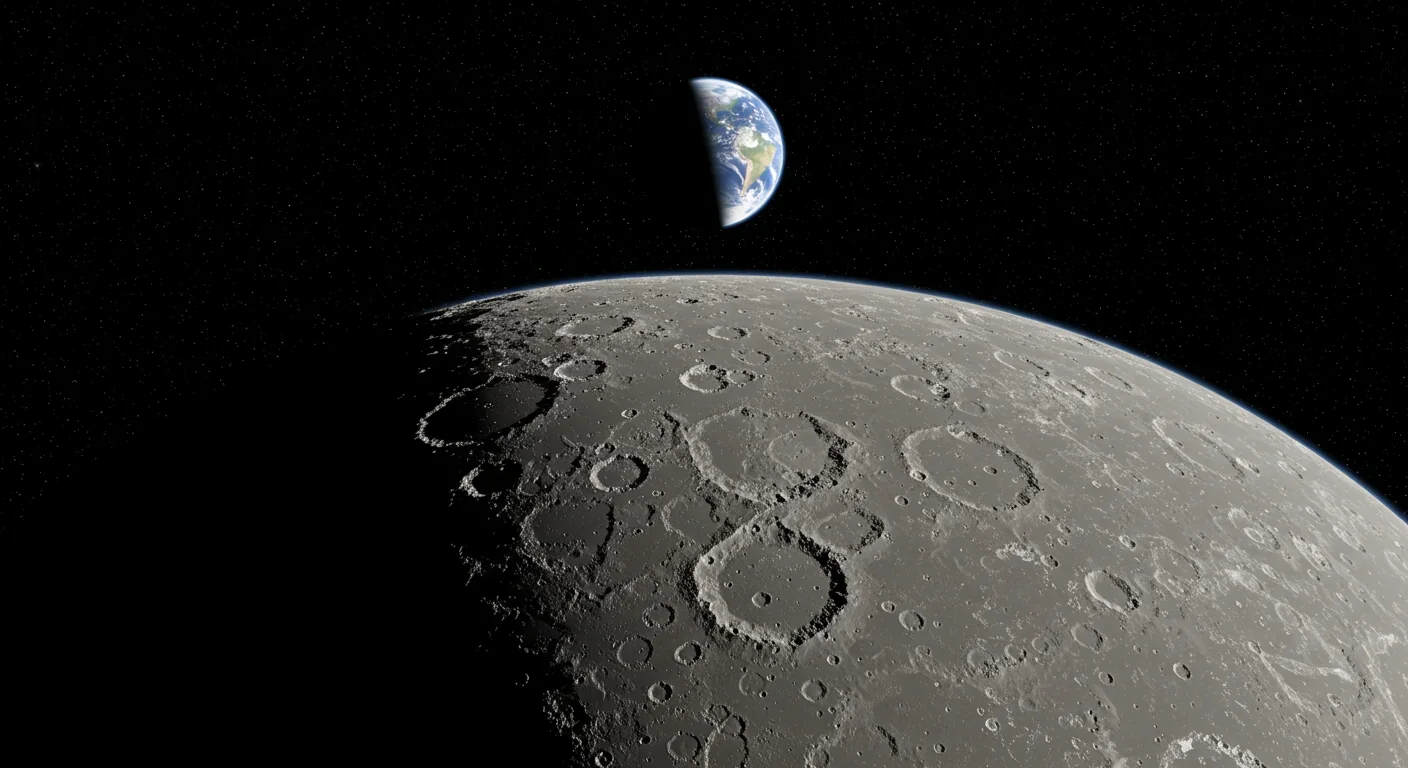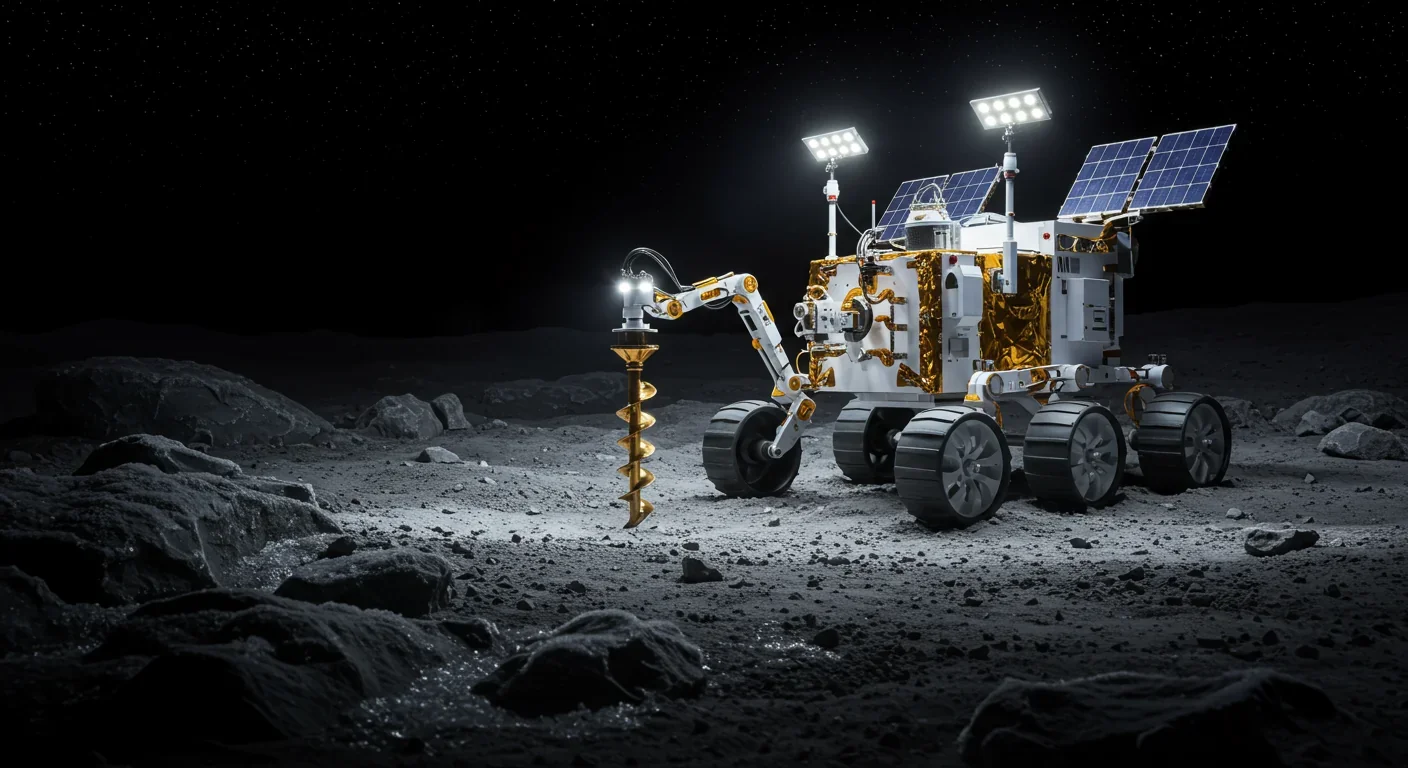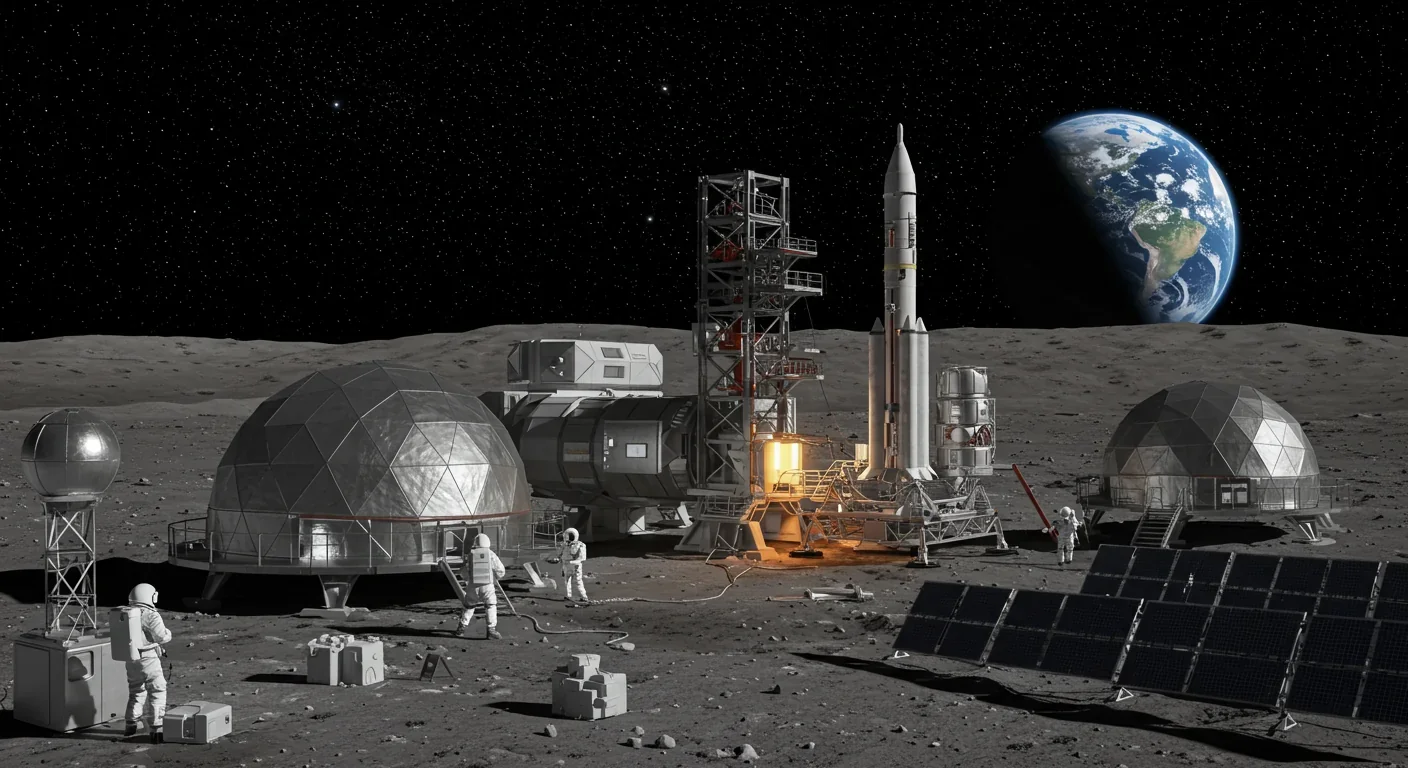The Gravity Heresy: MOND vs Dark Matter Theory Explained

TL;DR: Billions of tonnes of water ice confirmed in lunar shadowed craters transform the Moon from destination to resource hub, enabling sustained human presence and deep-space missions through local fuel production.

Within the next decade, human boots will touch lunar soil again. But this time, we're not just visiting. We're staying. And the key to turning the Moon from a destination into a home lies hidden in places where sunlight has never reached: permanently shadowed craters harboring billions of tonnes of water ice. What started as scientific speculation has become confirmed reality, fundamentally changing how we think about humanity's next frontier.
The story begins with a puzzle. For decades, scientists wondered whether Earth's bone-dry companion could possibly harbor water. The Moon lacks an atmosphere, endures temperature swings of hundreds of degrees, and gets bombarded by solar radiation that should strip away any volatile molecules. Yet in 2009, everything changed.
NASA's LCROSS mission deliberately crashed a spacecraft into Cabeus crater near the lunar south pole. The impact threw up a plume of debris that instruments analyzed in real-time. The results were stunning: 5.6% of the ejected material was water by mass, roughly equivalent to a dozen two-gallon buckets of water in every ton of lunar soil.
This wasn't a fluke. The Lunar Reconnaissance Orbiter's instruments mapped hydrogen concentrations across the poles. India's Chandrayaan-1 spacecraft detected hydroxyl molecules across the lunar surface, even in sunlit regions. By 2020, NASA's SOFIA telescope confirmed water exists as H2O molecules embedded in lunar dust in areas that see the sun.
The most recent analyses using topography-corrected imaging from Japan's SELENE mission found that Shackleton Crater's inner walls contain about 2-3% water ice by weight. When you scale that across the Moon's polar regions, estimates suggest between 600 million and several billion tonnes of accessible water ice.
The Moon's secret refrigerators work through an accident of geometry. Earth's axis tilts 23.5 degrees, giving us seasons. The Moon barely tilts at all, just 1.5 degrees. This means regions near the poles that lie at the bottom of deep craters never see direct sunlight, ever. Some of these permanently shadowed regions haven't felt warmth in over two billion years.
Temperatures in these cold traps hover around 100 Kelvin, that's negative 173 degrees Celsius. At those temperatures, water ice is as stable as rock. Any water molecule that wanders into these regions through comet impacts, solar wind interactions, or volcanic outgassing gets trapped and frozen solid. Over billions of years, ice has accumulated layer by layer.
But here's what makes this remarkable: the ice isn't sitting in pure sheets on the surface. LRO's radar observations show the water ice exists as small discrete pieces less than 10 centimeters across, mixed throughout the lunar regolith. Think of it like chocolate chips distributed through cookie dough, not a solid chocolate bar.
Recent research from China's Chang'e-5 mission revealed another surprise: microscopic glass beads created by ancient impacts can trap and store water in their pores. These beads, scattered across the lunar surface, might collectively hold up to 270 billion tonnes of water, providing a more accessible resource than mining deep into shadowed crater floors.

The hunt for lunar water began in earnest in 1998 when Lunar Prospector detected elevated hydrogen near the poles using a neutron spectrometer. Hydrogen signatures strongly suggested water ice, but the evidence remained circumstantial.
The breakthrough came from India. In 2008, Chandrayaan-1 carried NASA's Moon Mineralogy Mapper, which detected absorption features at 3 micrometers, the signature of water and hydroxyl molecules. For the first time, we had direct spectroscopic evidence. The mission detected water signatures in 650 separate locations across the lunar surface.
Then came LCROSS in 2009, the mission that literally made a splash. By analyzing the debris plume in real-time with multiple instruments, scientists determined not just that water existed, but exactly how much. The 5.6% concentration was far higher than expected, suggesting rich ice deposits rather than trace amounts.
Since 2009, NASA's Lunar Reconnaissance Orbiter has been continuously mapping the Moon's surface, building an ever-more detailed picture of where water hides and how much exists. Its Lunar Exploration Neutron Detector shows regions where epithermal neutron flux is suppressed, the telltale sign of hydrogen, and therefore water.
In 2023, using SOFIA telescope data, NASA produced the first detailed wide-area map of lunar water extending to the South Pole, precisely the region targeted for the upcoming Artemis missions. We now know not just that lunar water exists, but where to find it.
Here's the economic reality: launching one kilogram of water from Earth to the Moon costs roughly $100,000 using current rockets. A single astronaut needs about 11 kilograms of water per day for drinking, hygiene, and food preparation. Do the math on a permanent lunar base, and you're looking at costs that would bankrupt nations.
But if you can extract water already on the Moon, the economics flip entirely. Water isn't just for drinking. Through electrolysis, you can split H2O into hydrogen and oxygen, creating rocket fuel. Oxygen makes up about 85% of rocket propellant by weight. Lunar ice deposits essentially represent pre-positioned fuel depots.
This transforms mission architecture completely. Instead of carrying all your fuel from Earth, you could launch with just enough to reach the Moon, refuel there using local resources, and continue to Mars or asteroids. The Moon becomes a cosmic gas station, a strategic logistics hub that makes the entire solar system more accessible.
The implications extend beyond propulsion. Water provides radiation shielding when you surround habitats with it. It enables agriculture through hydroponic systems. Through chemical reactions with lunar regolith, you can create breathable oxygen for life support. A single resource unlocks multiple survival systems.
NASA's PRIME-1 mission, scheduled to launch soon, will test drilling technology capable of extracting ice samples from permanently shadowed regions. Meanwhile, the VIPER rover, planned for the South Pole, will map ice deposits in detail and test extraction methods in real Lunar conditions.
Mining ice from permanently shadowed craters isn't a simple matter of showing up with a shovel. The technical challenges span thermal, robotic, and operational domains.
First, there's the temperature problem. Mining equipment designed for Earth needs to function at temperatures that would freeze CO2 solid. Most materials become brittle. Batteries drain rapidly. Any water you extract will instantly freeze unless you have a heating system. But heating requires energy, and solar panels don't work in permanent shadow.
Several solutions are emerging. Blue Origin's Blue Alchemist project demonstrated technology that processes lunar regolith using solar power from illuminated crater rims, generating oxygen and leaving silicon and metals as byproducts. Other concepts involve buried solar receivers that concentrate sunlight to melt subsurface ice, channeling it to collection systems.
Robots will need unprecedented autonomy. Communication with Earth has a several-second delay, making remote control impossible for real-time operations. The mining robots must navigate treacherous terrain in pitch darkness, identify ice-rich areas, extract material, and process it without constant human supervision.
One promising approach uses swarm robotics inspired by nature. Multiple small robots work together, coordinating through local communication to explore, map, and extract resources. If one fails, others continue the mission. This redundancy is crucial when repair missions cost millions and take weeks.
The question of where exactly to dig remains partially open. While we know ice exists in permanently shadowed regions, its concentration varies dramatically. Some areas might have rich, easily accessible deposits. Others might require digging through meters of dry regolith to reach useful concentrations. This is why NASA is sending VIPER to prospect before committing to permanent infrastructure.

What started as scientific exploration is evolving into economic competition. NASA's Artemis program aims to establish a sustained presence at the lunar South Pole, explicitly targeting ice-rich regions. China and Russia announced a joint International Lunar Research Station, also focused on the South Pole. India's space agency plans Chandrayaan-4, a sample return mission specifically targeting water ice.
Private companies are joining the rush. Companies like Lunar Outpost and Masten Space Systems have contracts to deliver payloads to the lunar surface. Some, like TransAstra, are developing space mining technology with lunar water as an early target.
This raises thorny questions about governance and ownership. The Outer Space Treaty of 1967 declares that "outer space is not subject to national appropriation," but it says nothing about private companies or resource extraction. The United States has taken the position through the Artemis Accords that extracting and using space resources is legal under international law.
Not everyone agrees. Some nations argue that lunar resources should be treated as common heritage of humanity, requiring international agreements before extraction begins. The debate mirrors disputes over deep-sea mining and Antarctic resources. As missions move from science to industry, these legal ambiguities will need resolution.
The economic stakes are substantial. One analysis estimated that if lunar water enabled fuel depots for Mars missions, it could reduce mission costs by tens of billions of dollars. Companies that establish reliable extraction and delivery systems could create entirely new industries. We're watching the birth of off-world resource economics.
Beyond its practical utility, lunar ice holds scientific treasures. Those permanently shadowed regions have been collecting samples of Solar System history for billions of years. Comets that crashed into the Moon delivered water that froze in place, creating a geological record of impacts and volatile delivery through time.
Some of these cold traps may have been accumulating ice since the Moon's formation over four billion years ago. By drilling cores through ice layers, similar to how we study Earth's ice sheets, scientists could read the history of water delivery to the inner Solar System, volcanic activity on the ancient Moon, and even the evolution of the Sun's output.
Recent research suggests that permanently shadowed regions are younger than previously thought, perhaps only hundreds of millions of years old rather than billions. This changes our understanding of how lunar ice accumulates and where the oldest deposits might be found. The mystery deepens rather than resolves.
There's even evidence that Earth's magnetosphere contributes to lunar water formation. When the Moon passes through Earth's magnetic tail, which shields it from solar wind, hydrogen ions from Earth's atmosphere may reach the lunar surface and combine with oxygen in minerals to form water. The Moon and Earth remain connected in unexpected ways.
If you're a student wondering what skills will matter in this new era, consider that modeling energy requirements for oxygen production on the Moon is now serious research with funding. Robotics engineers who understand extreme environment operations are in demand. Expertise in resource extraction, power systems for space, and autonomous operations will be valuable as lunar industry develops.
The first lunar mining operations will likely be small, supporting scientific outposts and demonstrating technology. But if the economics work, scale will follow. Within your lifetime, it's plausible that hundreds or thousands of tonnes of lunar water will be extracted annually, supporting a permanent human presence not just on the Moon but throughout the inner Solar System.
The psychological shift matters as much as the technical one. For most of history, space resources were theoretical, something that might exist if we looked for them. Now they're confirmed, mapped, and targeted for extraction. The Moon has transformed from a dead rock to a resource-rich stepping stone. This changes everything about how we plan the human future in space.
We stand at an inflection point. The scientific question, "Is there water on the Moon?" has been definitively answered: yes, in quantities sufficient to sustain human presence. The engineering question, "Can we extract and use it?" is being answered through current technology development programs. The economic question, "Does it make financial sense?" increasingly points toward yes, particularly for enabling deeper space missions.
What remains open is the question of will and coordination. Getting from scientific confirmation to industrial operation requires sustained investment, international cooperation on governance frameworks, and breakthroughs in extraction technology. It requires treating the Moon not as a destination but as infrastructure.
The permanently shadowed craters that preserve ancient ice are becoming the most valuable real estate off Earth. In a cosmic irony, the darkest places on the lunar surface, untouched by sunlight for eons, may be what illuminates humanity's path beyond our home planet. The water that's been waiting there for billions of years is finally about to serve its purpose: enabling life and civilization to take root on another world.
Research from UNM and ongoing mission planning shows we're moving from exploration to utilization. The next time someone looks up at the Moon, they might be seeing not just a celestial object, but humanity's first off-world industrial site, powered by ice that fell from comets before humans existed.

MOND proposes gravity changes at low accelerations, explaining galaxy rotation without dark matter. While it predicts thousands of galaxies correctly, it struggles with clusters and cosmology, keeping the dark matter debate alive.

Ultrafine pollution particles smaller than 100 nanometers can bypass the blood-brain barrier through the olfactory nerve and bloodstream, depositing in brain tissue where they trigger neuroinflammation linked to dementia and neurological disorders, yet remain completely unregulated by current air quality standards.

CAES stores excess renewable energy by compressing air in underground caverns, then releases it through turbines during peak demand. New advanced adiabatic systems achieve 70%+ efficiency, making this decades-old technology suddenly competitive for long-duration grid storage.

Our brains are hardwired to see patterns in randomness, causing the gambler's fallacy—the mistaken belief that past random events influence future probabilities. This cognitive bias costs people millions in casinos, investments, and daily decisions.

Forests operate as synchronized living systems with molecular clocks that coordinate metabolism from individual cells to entire ecosystems, creating rhythmic patterns that affect global carbon cycles and climate feedback loops.

Generation Z is the first cohort to come of age amid a polycrisis - interconnected global failures spanning climate, economy, democracy, and health. This cascading reality is fundamentally reshaping how young people think, plan their lives, and organize for change.

Zero-trust security eliminates implicit network trust by requiring continuous verification of every access request. Organizations are rapidly adopting this architecture to address cloud computing, remote work, and sophisticated threats that rendered perimeter defenses obsolete.